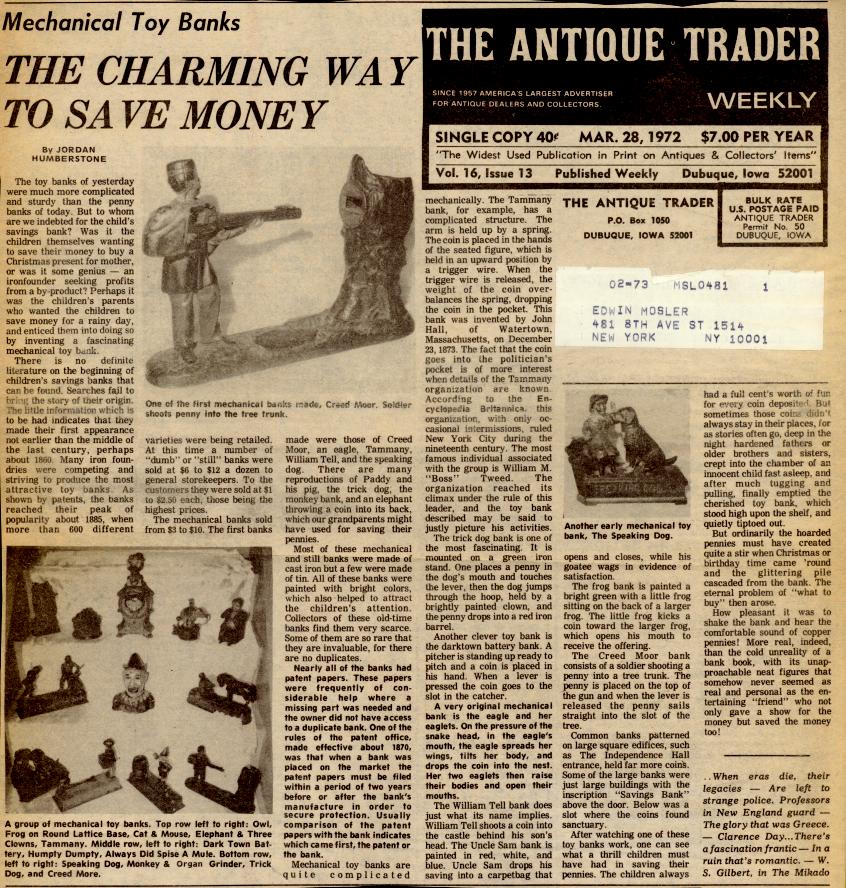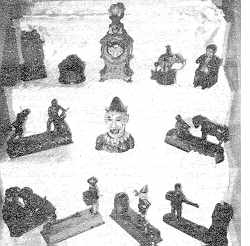| THE ANTIQUE TRADER, March 28, 1972, By Jordan Humberstone Mechanical Toy Banks THE CHARMING WAY TO SAVE MONEY
There is no definite literature on the beginning of children’s savings banks that can be found. Searches fail to bring the story of their origin. The little information which is to be had indicates that they made their first appearance not earlier than the middle of the last century, perhaps about 1860. Many iron foundries were competing and striving to produce the most attractive toy banks. As shown by patents, the banks reached their peak of popularity about 1885, when more than 600 different varieties were being retailed. At this time a number of "dumb" or "still" banks were sold at $6 to $12 a dozen to general storekeepers. To the customers they were sold at $1 to $2.50 each, those being the highest prices. The mechanical banks sold from $3 to $10. The first banks made were those of Creed Moor, an eagle, Tammany, William Tell, and the speaking dog. There are many reproductions of Paddy and his pig, the trick dog, the monkey bank, and an elephant throwing a coin into its back, which our grandparents might have used for saving their pennies. Most of these mechanical and still banks were made of cast iron but a few were made of tin. All of these banks were painted with bright colors, which also helped to attract the children’s attention. Collectors of these old-time banks find them very scarce. Some of them are so rare that they are invaluable, for there are no duplicates. Nearly all of the banks had patent papers. These papers were frequently of considerable help where a missing part was needed and the owner did not have access to a duplicate bank. One of the rules of the patent office, made effective about 1870, was that when a bank was placed on the market the patent papers must be filed within a period of two years before or after the bank’s manufacture in order to secure protection. Usually comparison of the patent papers with the bank indicates which came first, the patent or the bank. Mechanical toy banks are quite complicated mechanically. The Tammany bank, for example, has a complicated structure. The arm is held up by a spring. The coin is placed in the hands of the seated figure, which is held in an upward position by a trigger wire. When the trigger wire is released, the weight of the coin over-balances the spring, dropping the coin in the pocket. This bank was invented by John Hall, of Watertown, Massachusetts, on December 23, 1873. The fact that the coin goes into the politician’s pocket is of more interest when details of the Tammany organization are known. According to the Encyclopedia Britannica, this organization, with only occasional intermissions, ruled New York City during the nineteenth century. The most famous individual associated with the group is William M. "Boss" Tweed. The organization reached its climax under the rule of this leader, and the toy bank described may be said to justly picture his activities. The trick dog bank is one of the most fascinating. It is mounted on a green iron stand. One places a penny in the dog’s mouth and touches the lever, then the dog jumps through the hoop, held by a brightly painted clown, and the penny drops into a red iron barrel. Another clever toy bank is the darktown battery bank. A pitcher is standing up ready to pitch and a coin is placed in his hand. When a lever is pressed the coin goes to the slot in the catcher. A very original mechanical bank is the eagle and her eaglets. On the pressure of the snake head, in the eagle’s mouth, the eagle spreads her wings, tilts her body, and drops the coin into the nest. Her two eaglets then raise their bodies and open their mouths. The William Tell bank does just what its name implies. William Tell shoots a coin into the castle behind his son’s head. The Uncle Sam bank is painted in red, white, and blue. Uncle Sam drops his saving into a carpetbag that opens and closes, while his goatee wags in evidence of satisfaction. The frog bank is painted a bright green with a little frog sitting on the back of a larger frog. The little frog kicks a coin toward the larger frog, which opens his mouth to receive the offering. The Creed Moor bank consists of a soldier shooting a penny into a tree trunk. The penny is placed on the top of the gun and when the lever is released the penny sails straight into the slot of the tree. Common banks patterned on large square edifices, such as The Independence Hall entrance, held far more coins. Some of the large banks were just large buildings with the inscription "Savings Bank" above the door. Below was a slot where the coins found sanctuary. After watching one of these toy banks work, one can see what a thrill children must have had in saving their pennies. The children always had a full cent’s worth of fun for every coin deposited. But sometimes those coins didn’t always stay in their places, for as stories often go, deep in the night hardened fathers or older brothers and sisters, crept into the chamber of an innocent child fast asleep, and after much tugging and pulling, finally emptied the cherished toy bank, which stood high upon the shelf, and quietly tiptoed out. But ordinarily the hoarded pennies must have created quite a stir when Christmas or birthday time came ’round and the glittering pile cascaded from the bank. The eternal problem of "what to buy" then arose. How pleasant it was to shake the bank and hear the comfortable sound of copper pennies! More real, indeed, than the cold unreality of a bank book, with its unapproachable neat figures that somehow never seemed as real and personal as the entertaining "friend" who not only gave a show for the money but saved the money too! |


 The toy banks of yesterday were much
more complicated and sturdy than the penny banks of today. But to whom are we indebted for
the child’s savings bank? Was it the children themselves wanting to save their money
to buy a Christmas present for mother, or was it some genius — an iron-founder
seeking profits from a by-product? Perhaps it was the children’s parents who wanted
the children to save money for a rainy day, and enticed them into doing so by inventing a
fascinating mechanical toy bank.
The toy banks of yesterday were much
more complicated and sturdy than the penny banks of today. But to whom are we indebted for
the child’s savings bank? Was it the children themselves wanting to save their money
to buy a Christmas present for mother, or was it some genius — an iron-founder
seeking profits from a by-product? Perhaps it was the children’s parents who wanted
the children to save money for a rainy day, and enticed them into doing so by inventing a
fascinating mechanical toy bank.